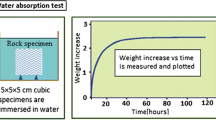Abstract
Laboratory compressive experiments are regarded as the most accurate method to obtain the strength parameters of rock, and the rocks used for experiments are often dry. However, in geotechnical engineering, the rock masses are often under different hydraulic environments because of which rock strength decreases by varying degrees; consequently, there are considerable differences between laboratory results and engineering practices. Research on the quantitative relationships between rock strength and water content would contribute to the application of laboratory results to engineering practice and can become the basis for engineering rock mass stability analysis and forecasting. On the basis of 14 different groups of rock strength data with different water contents, statistical and numerical methods are used to obtain the least squares fit relationship between rock strength and water content, and the fitting results demonstrate that sandstone strength and water content have a negative exponential relationship. Meanwhile, through parameter analysis, we obtain the physical meaning of each parameter in the three-parameter exponential fitting curves, thus establishing the laws that govern the weakening of rock uniaxial compressive strength. The newly established model takes the rock porosity and water content into account, and the rock strength at a certain water content can be computed according to the experimentally obtained rock strength in dry and completely water-saturated conditions, as well as the rock porosity. The model has been validated by two case studies using comparative analysis between theoretical values and experimental data.






Similar content being viewed by others
References
Ajalloeian R, Lashkaripour GR (2000) Strength anisotropies in mudrocks. Bull Eng Geol Environ 59(3):195–199
Al-Harthi AA, Al-Amri RM, Shehata WM (1999) The porosity and engineering properties of vesicular basalt in Saudi Arabia. Eng Geol 54(3):313–320
Ballivy G, Ladanyi B, Gill DE (1976) Effect of water saturation history on the strength of low-porosity rocks. ASTM Spec Tech Publ 599:4–20
Broch E (1974) The influence of water on some rock properties. Proc 3rd Cong Int Soc Rock Mech II 74(1974):33–38
Colback P, Wiid BL (1965) The influence of moisture content on the compressive strength of rocks. Proceedings of the rock mechanics symposium: 3rd Canadian symposium, Sympo, pp. 65–83
Dearman WR, Baynes FJ, Irfan TY (1978) Engineering grading of weathered granite. Eng Geol 12:345–374
Dube AK, Singh B (1972) Effect of humidity on tensile strength of sandstone. J Mines Met Fuels 20(1):8–10
Dunn DE, LaFountain LJ, Jackson RE (1973) Porosity dependence and mechanism of brittle fracture in sandstones. J Geophys Res 78(14):2403–2417
Erguler ZA, Ulusay R (2009) Water-induced variations in mechanical properties of clay-bearing rocks. Int J Rock Mech Min Sci 46(2):355–370
Farquhar RA, Somerville JM, Smart B 1994 Porosity as a geomechanical indicator: an application of core and log data and rock mechanics. European Petroleum Conference. Society of Petroleum Engineers, London, pp. 481–489 (SPE 28853)
Hale PA, Shakoor A (2003) A laboratory investigation of the effects of cyclic heating and cooling, wetting and drying, and freezing and thawing on the compressive strength of selected sandstones. Environ EngGeosci 9(2):117–130
Hawkins AB, McConnell BJ (1992) Sensitivity of sandstone strength and deformability to changes in moisture content. Q J Eng Geol Hydrogeol 25(2):115–130
Koncagül EC, Santi PM (1999) Predicting the unconfined compressive strength of the Breathitt shale using slake durability, shore hardness and rock structural properties. Int J Rock Mech Min Sci 36(2):139–153
Li D, Wong LNY, Liu G, et al. (2012) Influence of water content and anisotropy on the strength and deformability of low porosity meta-sedimentary rocks under triaxial compression. Eng Geol 126:46–66
Masuda K (2001) Effects of water on rock strength in a brittle regime. J Struct Geol 23(11):1653–1657
Meng ZP, Li MS, Lu PQ, et al. (2006) Temperature and pressure under deep conditions and their influences on mechanical properties of sandstone. Chin J Rock Mech Eng 25(6):1177–1181
Meng ZP, Pan JN, Liu LL, et al. (2009) Influence of moisture contents on mechanical properties of sedimentary rock and its bursting potential. Chin J Rock Mech Eng 28(1):2637–2643
Palchik V (2006) Application of Mohr–Coulomb failure theory to very porous sandy shales. Int J Rock Mech Min Sci 43(7):1153–1162
Palchik V, Hatzor YH (2004) The influence of porosity on tensile and compressive strength of porous chalks. Rock Mech Rock Eng 37(4):331–341
Shukla R, Ranjith PG, Choi SK, et al. (2013) Mechanical behaviour of reservoir rock under brine saturation. Rock Mech Rock Eng 46(1):83–93
Siedel H (2010) Historic building stones and flooding: changes of physical properties due to water saturation. J Perform Constr Facil 24(5):452–461
Török Á, Vásárhelyi B (2010) The influence of fabric and water content on selected rock mechanical parameters of travertine, examples from Hungary. Eng Geol 115(3):237–245
Vásárhelyi B (2002) Influence of the water saturation on the strength of volcanic tuffs. ISRM International Symposium—EUROCK, Madeira, pp. 89–96
Vásárhelyi B (2003) Some observations regarding the strength and deformability of sandstones in dry and saturated conditions. Bull Eng Geol Environ 62(3):245–249
Vásárhelyi B (2005) Statistical analysis of the influence of water content on the strength of the Miocene limestone. Rock Mech Rock Eng 38(1):69–76
Vásárhelyi B, Ván P (2006) Influence of water content on the strength of rock. Eng Geol 84(1):70–74
Vernik L, Bruno M, Bovberg C (1993) Empirical relations between compressive strength and porosity of siliciclastic rocks. Int J Rock Mech Miner Sci 30:677–680
Yilmaz I (2010) Influence of water content on the strength and deformability of gypsum. Int J Rock Mech Min Sci 47(2):342–347
Acknowledgments
This work was financially supported by the Open Fund (Number: PLN1421) of the State Key Laboratory of Oil and Gas Reservoir Geology and Exploitation (Southwest Petroleum University), the SWPU Science & Technology Fund (Number: 2013XJZ029), the scientific fund of the Sichuan Provincial Education Department (Number: 14ZB0060), and the CNPC Key Laboratory of Drilling Engineering.
Author information
Authors and Affiliations
Corresponding author
Rights and permissions
About this article
Cite this article
Shi, X., Cai, W., Meng, Y. et al. Weakening laws of rock uniaxial compressive strength with consideration of water content and rock porosity. Arab J Geosci 9, 369 (2016). https://doi.org/10.1007/s12517-016-2426-6
Received:
Accepted:
Published:
DOI: https://doi.org/10.1007/s12517-016-2426-6




